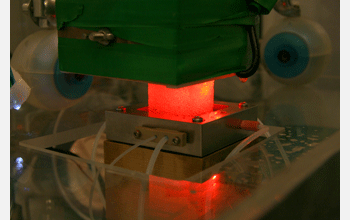Multimedia Gallery
Ice Core Reveals Pollution History
An ice core sample sits on a melter head in a cold laboratory (-20 degrees Celsius) at the Desert Research Institute. The longitudinal ice core sample falls by gravity onto the heated melter plate and the melt water splits into three streams by grooves etched into the melter head. Only the inner most 10 percent of the melt water is used for ultra-trace elemental measurements; the middle 20 percent is used for major ion and particle size determinations; and the potentially contaminated outer 70 percent of the melt water is discarded. All chemical and elemental measurements are made in real-time. Data gleaned from Greenland ice cores show pollution levels were higher in the Arctic 100 years ago than today, confounding researcher expectations that pollution was at its peak in the 1960s and 1970s.
More about this Image
A study that found pollution levels were higher in the Arctic a century ago than today was led by Joe McConnell, lead researcher and director of the Desert Research Institute's (DRI) Ultra-Trace Chemistry Laboratory in Reno, Nev., and partially funded by the National Science Foundation.
Detailed measurements from a Greenland ice core show pollutants from burning coal--which include the toxic heavy metals cadmium, thallium and lead--were much higher than expected. However, McConnell was surprised to find that the pollutants weren't higher at the times when researchers expected peaks--in the 1960s and 1970s, the peak of industrial activity in Europe and North America and preceding the implementation of Clean Air Act controls in the early 1970s. Instead, data showed that pollution in southern Greenland was higher 100 years ago, when North American and European economies ran on coal, and before the advent of cleaner, more efficient coal burning technologies and the switch to oil- and gas-based economies. In fact, research showed pollutants were two to five times higher at the beginning of the previous century than today. Pollution levels in the early 1900s also represented a 10-fold increase from preindustrial levels.
The results of the study were produced using records of continuous, monthly and annual pollution averages taken from Greenland ice cores and dating from 1772 to 2003. There is still cause for concern however. Although heavy-metal pollution in the North Atlantic sector of the Arctic is substantially lower today than a century ago, contamination of other sectors may be increasing due to rapid coal-driven growth of Asian economies. This could greater risk to the food chain as toxic heavy metals from these industrial activities are transported through the atmosphere and deposited in the polar regions. Food chain contamination through toxic metal absorption from both the environment and from consumption of contaminated food sources could make its way to humans, who feed on land and marine animals, such as caribou, seals and whale. The impact on human health of these activities in the Arctic region hasn't been determined yet, but McConnell suggests that cleaner burning coal technologies, or better yet, reduced reliance on coal burning, may head off the potential problem.
[The continuous ice core analytical method was developed with funding from National Science Foundation (NSF) grants OPP 99-77252 and refined and applied to Greenland ice cores as part of NSF grant OPP 02-21515. The ultra-trace ice core laboratory primarily was instrumented with funding from NSF Major Research Instrumentation grants OPP 02-16552 and OPP 04-21412.] (Date of Image: January 2008)
Credit: Joseph McConnell, Desert Research Institute
Images and other media in the National Science Foundation Multimedia Gallery are available for use in print and electronic material by NSF employees, members of the media, university staff, teachers and the general public. All media in the gallery are intended for personal, educational and nonprofit/non-commercial use only.
Images credited to the National Science Foundation, a federal agency, are in the public domain. The images were created by employees of the United States Government as part of their official duties or prepared by contractors as "works for hire" for NSF. You may freely use NSF-credited images and, at your discretion, credit NSF with a "Courtesy: National Science Foundation" notation.
Additional information about general usage can be found in Conditions.
Also Available:
Download the high-resolution JPG version of the image. (768 KB)
Use your mouse to right-click (Mac users may need to Ctrl-click) the link above and choose the option that will save the file or target to your computer.

